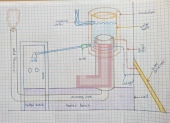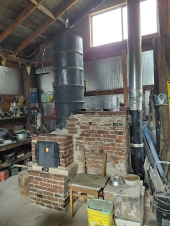Mark, you make an interesting point.
As I've followed the development over the years I've seen the consensus around chimneys shift.
In the early days many people insisted that a normal vertical chimney was not needed,now most people involved in the making of rocket mass heater seem to think it is best practice to use these kinds of chimneys.
Rocket mass heaters with good chimneys can still be subject to back draft.
A good insulated chimney is one thing that helps prevent that.
Heating that chimney also helps.
Most current designs call for a "bypass" that routes the exhaust gasses directly to the chimney, "bypassing " the horizontal piping.
Once the chimney is sufficient hot , the bypass is closed and the exhaust gassed are drawn through horizontal flues that are buried in the thermal mass.
Once the thermal mass is hot enough, the heat it gives off is usually enough to create draft, meaning there might not be a reason to use the bypass except for when the mass is stone cold.
You mentioned the a simple firebox in one place and the inevitability of creosote production in another.
The dimensions, geometry and material of a properly built rocket mass heater create a burn intense enough that no creosote is produced.
Most of the research around rocket mass heaters centers on perfecting this part of the design, known as the core.
It's simple enough , in execution, if you follow the formulas laid out, but the designs themselves are not simple.
Because the fires in rocket mass heaters burn hot,fast, and clean, there are not a lot of points where hot coals are sitting unattended.
Because there is no thermal mass around a conventional wood stove, users seem to favor low smoldering fires for unattended heat.
In either case, hots coals and a back draft would be a disaster, but a rocket mass heater doesn't depend on smoldering
fires for long lasting heat.
Your posts make me think you might not know how the "bell" form of thermal mass.
I've recently tried to explain the principles of how a bell works and seemed to fumble it rather badly , so I'll leave that to someone else.









